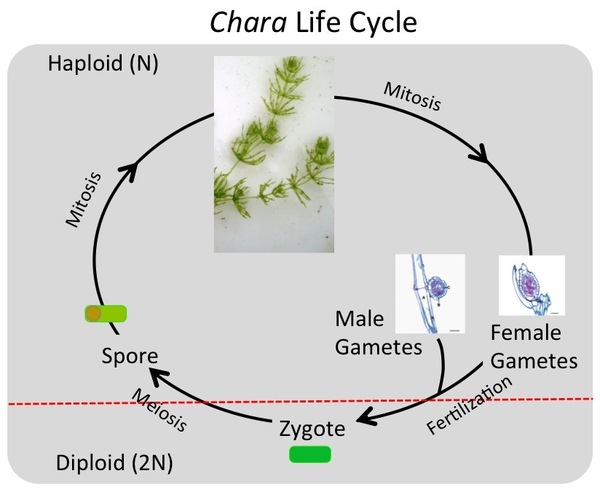| << Chapter < Page | Chapter >> Page > |

The classification of eukaryotes is still in flux, and the six supergroups may be modified or replaced by a more appropriate hierarchy as genetic, morphological, and ecological data accumulate. Keep in mind that the classification scheme presented here is just one of several hypotheses, and the true evolutionary relationships are still to be determined. For this module, we are focusing on the Archaeplastida which contain the green algae - the group of organisms most closely related to plants.
Red algae and green algae are included in the supergroup Archaeplastida. It was from a common ancestor of these organisms that the land plants evolved, since their closest relatives are found in this group. Molecular evidence supports that all Archaeplastida are descendents of an endosymbiotic relationship between a heterotrophic protist and a cyanobacterium. The red and green algae include unicellular, multicellular, and colonial forms.
Red algae, or rhodophytes, lack flagella and range in size from microscopic unicellular forms to large, multicellular forms grouped into the informal 'seaweed' category. Most red algae are multicellular. The red algae life cycle is an alternation of generations (explained in next section). Some species of red algae contain phycoerythrins, photosynthetic accessory pigments that are red in color and outcompete the green tint of chlorophyll, making these species appear as varying shades of red. Other species classified as red algae lack phycoerythrins and are parasites. Red algae are common in tropical waters where they have been detected at depths of 260 meters. Other red algae exist in terrestrial or freshwater environments.
Red Algae are an economically important food source and additive. Have you ever eaten sushi rolls? If so, the crispy sheets wrapped around the rice are from the genus Porphyra (Japanese "nori"). The food stabilizer carrageenan is found in ice cream, yogurt and other food stuffs and is an extract from red algae. Another extract from red algae commonly used as a thickener and as vegetarian substitute for gelatin is agar. Agar is also commonly used by microbiologists as a solid substrate to contain culture media in order to grow bacteria.
The most abundant group of algae are the green algae. The green algae exhibit similar features to the land plants. The cell walls of green algae and land plants are made of cellulose and the chloroplasts of both groups contain chlorophylls a and b. The hypothesis that this group of protists shared a relatively recent common ancestor with land plants is well supported. The green algae are subdivided into the chlorophytes and charophytes. The charophytes are the closest living relatives to land plants and resemble them in morphology and reproductive strategies. Charophytes are common in wet habitats, and their presence often signals a healthy ecosystem.
Green algae are as a group of organisms an integral part of a functional ecosystem, and humans have been using green algae as a food source and as a medicine for a long time. In aquatic environments, green algae are a major primary producer and release a substantial amount of oxygen in the system. So a healthy ecosystem is dependent on a healthy population of green algae. As a economic benefit to humans, green algae are used a food source (Asakusa Nori) for humans and are used a food thickening agent. Green algae are used in the agricultural industry as a food source for cattle, and as fertilizer.
The chlorophytes exhibit great diversity of form and function. Chlorophytes primarily inhabit freshwater and damp soil, and are a common component of plankton. Chlamydomonas is a simple, unicellular chlorophyte with a pear-shaped morphology and two opposing, anterior flagella that guide this protist toward light sensed by its eyespot.
Volvox is an example of multicellularity in the Chlorophytes ( [link] ). Volvox colonies contain 500 to 60,000 cells, each with two flagella, contained within a hollow, spherical matrix composed of a gelatinous glycoprotein secretion. Volvox moves by rolling in a coordinated fashion. The cells forming the sphere on the outside do not reproduce while the green cells inside do reproduce, demonstrating division of labor.

True multicellular organisms, such as the sea lettuce, Ulva , are represented among the chlorophytes. In addition, some chlorophytes exist as large, multinucleate, single cells. Species in the genus Caulerpa exhibit flattened fern-like foliage and can reach lengths of 3 meters ( [link] ). Caulerpa species undergo nuclear division, but their cells do not complete cytokinesis, remaining instead as massive and elaborate single cells.

Charophytes are the closest related green algae to land plants, this conclusion was drawn from studies of nuclear and chloroplast genes from many different types of plants and algae. In addition to the similarities listed above, there a some additional structural similarities such as cellulose-synthesizing proteins, the structure of the flagellated sperm and the gamete producing structures that suggest that land plants arose from within the charophyta group. This does not mean land plants are descended from living green algae, but it does allow us to explore the algal ancestor to land plants. For example, the exploration of the Chara life cycle
[link] allows us visualize the similarities between the life cycle of green algae and land plants.


Notification Switch
Would you like to follow the 'Principles of biology' conversation and receive update notifications?